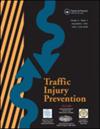Interactions between rearward-facing child restraint systems and the center console in frontal impact sled tests
IF 1.6
3区 工程技术
Q3 PUBLIC, ENVIRONMENTAL & OCCUPATIONAL HEALTH
引用次数: 0
Abstract
Objective
To quantify the head and chest injury metrics associated with a pediatric anthropomorphic test device (ATD) in rearward-facing infant child restraint system (CRS) models positioned directly behind a center console during frontal impact sled tests.
Methods
Sled tests using the Federal Motor Vehicle Safety Standard (FMVSS) 213 frontal crash pulse were performed. The test buck comprised a second row middle seat and center console from the same 2023 model mid-size SUV spaced as per the in-vehicle relative dimensions, a force plate covered with an automotive floor mat, a post-mounted shoulder belt simulating the in-vehicle roof-mounted seatbelt and an array of high-speed cameras. The 12-month-old Child Restraint/Air Bag Interaction (CRABI-12) ATD was seated in one of two rearward-facing infant CRS models (model A, rigid lower anchors; model B, flexible lower anchors), which was installed with either the base (support leg or no support leg; attached using lower anchors or the seatbelt) or without the base (attached using the European or US belt path). Conductive foil was attached to the rear surface of the center console and to the shell of the CRS and/or base to quantify contact. The vehicle seat was replaced every second test and the center console was replaced when damaged.
Results
For sled tests of the CRS models with a base attached using lower anchors, there was no contact of the CRS with the center console when the support leg was used, and all head and chest injury metrics were reduced compared to the tests of CRS with no support leg. However, there was contact between the CRS and the center console when the base of the CRS models was attached using the seatbelt, which typically increased head and chest injury metrics compared to the lower anchor attachment method. For CRS model B with the base attached using either the lower anchors or the seatbelt but no support leg, head acceleration 3 ms clip exceeded the injury assessment reference value (IARV) of 80 g. All tests resulted in HIC36 values below the IARV of 1000. The tests of the CRS models without a base using the European belt path did not result in contact and had the lowest head and chest injury metrics of all tests, which were all below IARVs. For the tests of the CRS models with the base attached using the seatbelt and tests using the US belt path, chest acceleration 3 ms clip values exceeded the IARV of 60 g. Peak normal support leg reaction forces in this study ranged from 3.6 to 4.3 kN.
Conclusions
The rearward-facing CRS models with a base and a support leg attached using lower anchors, or without a base using the European belt path, resulted in the lowest head and chest injury metrics due to not contacting the center console.
在正面碰撞雪橇测试中,后向儿童约束系统与中控台之间的相互作用。
目的:在正面碰撞雪橇测试中,对位于中控台正后方的后向式婴儿约束系统(CRS)模型中的小儿拟人测试装置(ATD)的头部和胸部损伤指标进行量化:方法:采用联邦机动车安全标准(FMVSS)213正面碰撞脉冲进行雪橇测试。测试桶由一个来自同一款 2023 年款中型 SUV 的第二排中间座椅和中控台组成,座椅和中控台之间的间距与车内相对尺寸一致,测试桶上有一个用汽车地板垫覆盖的受力板、一个模拟车顶安全带的后置肩带和一个高速摄像头阵列。12 个月大的儿童约束装置/气囊相互作用(CRABI-12)ATD 坐在两种后向式婴儿安全座椅中的一种(A 型,刚性下锚;B 型,柔性下锚),安装时可选择带底座(支撑腿或无支撑腿;使用下锚或安全带连接)或不带底座(使用欧洲或美国安全带路径连接)。导电箔被贴在中控台后表面和 CRS 和/或底座的外壳上,以量化接触情况。汽车座椅每进行两次测试就更换一次,中控台损坏后更换:在使用下锚连接底座的 CRS 模型的雪橇测试中,使用支撑腿时 CRS 与中控台没有接触,与没有支撑腿的 CRS 测试相比,所有头部和胸部伤害指标都有所降低。但是,当使用安全带连接 CRS 模型的底座时,CRS 与中控台之间会有接触,与较低的锚固连接方法相比,这通常会增加头部和胸部的伤害指标。对于使用下锚或安全带固定底座但没有支撑腿的 CRS 型号 B,头部加速度 3 毫秒夹超过了 80 g 的伤害评估参考值 (IARV)。所有测试的 HIC36 值均低于 IARV 1000。使用欧式安全带路径对无底座的 CRS 模型进行的测试没有造成接触,在所有测试中,头部和胸部受伤指标最低,均低于 IARV。在使用安全带连接底座的 CRS 模型测试和使用美国安全带路径的测试中,胸部加速度 3 毫秒夹值超过了 60 g 的 IARV。本研究中的正常支撑腿反作用力峰值为 3.6 至 4.3 千牛:结论:带有底座和支撑腿的后向式 CRS 车型使用下固定装置,或不带底座使用欧洲安全带路径,由于不接触中控台,因此头部和胸部受伤指标最低。
本文章由计算机程序翻译,如有差异,请以英文原文为准。
求助全文
约1分钟内获得全文
求助全文
来源期刊

Traffic Injury Prevention
PUBLIC, ENVIRONMENTAL & OCCUPATIONAL HEALTH-
CiteScore
3.60
自引率
10.00%
发文量
137
审稿时长
3 months
期刊介绍:
The purpose of Traffic Injury Prevention is to bridge the disciplines of medicine, engineering, public health and traffic safety in order to foster the science of traffic injury prevention. The archival journal focuses on research, interventions and evaluations within the areas of traffic safety, crash causation, injury prevention and treatment.
General topics within the journal''s scope are driver behavior, road infrastructure, emerging crash avoidance technologies, crash and injury epidemiology, alcohol and drugs, impact injury biomechanics, vehicle crashworthiness, occupant restraints, pedestrian safety, evaluation of interventions, economic consequences and emergency and clinical care with specific application to traffic injury prevention. The journal includes full length papers, review articles, case studies, brief technical notes and commentaries.
 求助内容:
求助内容: 应助结果提醒方式:
应助结果提醒方式:


